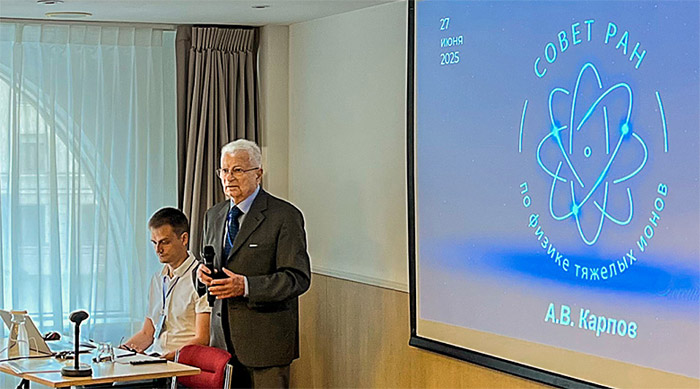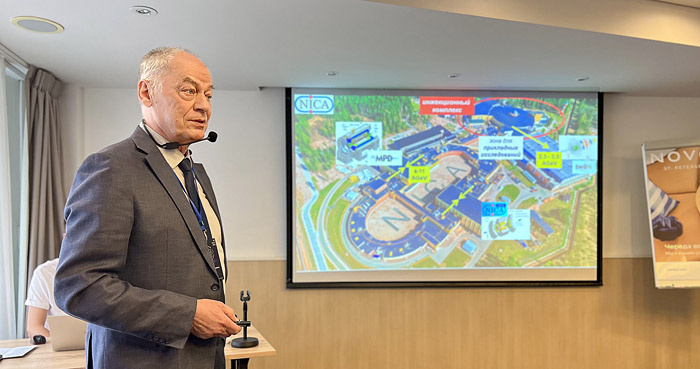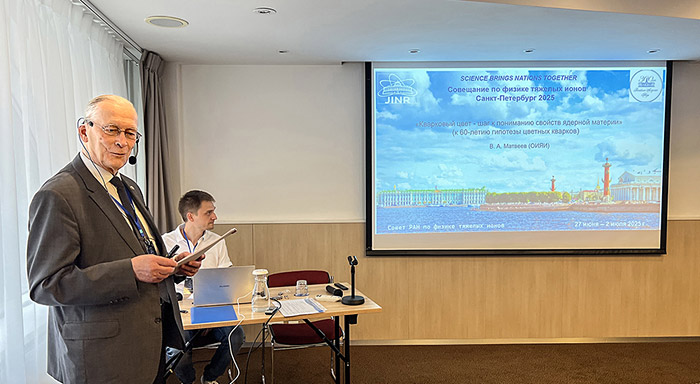
Electronic english version since 2022 |
The newspaper was founded in November 1957
| |
Meridians of cooperation
Meeting of RAS Council on Heavy Ion Physics
From 28 June to 1 July, a meeting of the Scientific Council of the Department of Physical Sciences of the Russian Academy of Sciences on Heavy Ion Physics "Relativistic nuclear physics and heavy ion physics" was held in St. Petersburg.
The results and prospects of scientific research in nuclear physics, the synthesis of superheavy elements, as well as plans for the implementation of large scientific projects and development of the required infrastructure for them were discussed at the meeting. Within the framework of the meeting, an agreement on the establishment of a joint research and training laboratory of St. Petersburg State University - JINR was signed.
Over four days, more than 30 reports were presented on projects and research in the field of heavy ion physics. More than 80 scientists from JINR, INR RAS, IAI RAS, IAP RAS, Rosatom State Corporation (RFNC - VNIIEF, plant "Electrokhimpribor", NIIEFA), SINP MSU, St. Petersburg State University, Institute of Biology of Yerevan State University, PNPI NRC KI and NCPM were engaged in the work of the Scientific Council of the Russian Academy of Sciences.
Chairman of the RAS Council, FLNR Scientific Leader Academician Yuri Oganessian opened the meeting. He stated that this is the fifth meeting of the current membership of the Council that is held on an annual basis as a conference. The participants of the meeting summarize the results of the year that has passed since the previous meeting and discuss research both in the near (one to two years) and in the longer term (up to five years). The meeting of the Council covers a wide range of tasks that require constant discussion and which many scientists are involved in both from Dubna and other cities of the Moscow Region, Leningrad, Nizhny Novgorod, Sverdlovsk and Ulyanovsk Regions of Russia, as well as from the scientific departments of the State Corporation "Rosatom". The synthesis of superheavy elements is only one of the topics of discussion at the Council of the Russian Academy of Sciences. The meeting also includes a wide range of other issues that require a versatile approach, such as atomic and relativistic physics, light and neutron-surplus nuclei. A separate item is the investigation of the physical and chemical properties of superheavy elements.

FLNR Scientific Leader Academician Yuri Oganessian
In his plenary report "Heavy ions in science and technology" Academician Yuri Oganessian presented the programme of the event and spoke about the past, present and future of research in the field of physics and chemistry of superheavy elements.
JINR Vice-Director Academician Vladimir Kekelidze spoke about development of the physical programme at the NICA accelerator complex. In March 2025, the first technological session at NICA was launched. Currently, VBLHEP prepares the accelerator complex for launching the beam into the collider. Vice-Director of the Joint Institute presented the results of the work of the MPD, BM@N and SPD international collaborations. Separately, Vladimir Kekelidze emphasized the applied research programme at NICA. Participants of the ARIADNA collaboration are going to carry out new experiments at the SOCHI and SIMBO irradiation stations.

JINR Vice-Director Academician Vladimir Kekelidze
The report of MLIT Scientific Leader Vladimir Korenkov was dedicated to digital technologies and intelligent data analysis in large scientific projects.
JINR Scientific Leader Academician Victor Matveev gave a report "Quark color is a step towards understanding the properties of nuclear matter (to the 60th anniversary of the hypothesis of colored quarks)".

JINR Scientific Leader Academician Victor Matveev
From the second day, the programme was held in six topical sessions: super-heavy cores; an atom in a supercritical field; SHE physics and chemistry: experiment and theory; light exotic nuclei; applied research; acceleration and target technologies.
On 29 June, Nikita Kovrizhnykh, Galina Knyazheva, Evgeny Yakushev, Alexander Svirikhin and Dmitry Soloviev delivered reports on the research of superheavy nuclei and the development of experimental facilities of the Laboratory of Nuclear Reactions.
On the last day of the meeting, chaired by JINR Director Academician Grigory Trubnikov, a section was held on the review of the current state of JINR's basic facilities in the field of nuclear physics, including the NICA accelerator complex in VBLHEP and the DLNP cyclotron complexes.
Yuri Oganessian emphasized that a whole range of facilities at both average and high energies are located on the territory of the Joint Institute that allows efficiently meeting various nuclear and physical tasks. "This "intersection" functions very well. In particular, neutron-rich nuclei could be produced using the NICA booster, its energy is 10-20 times higher than in the Laboratory of Nuclear Problems, where it is currently studied," Yuri Oganessian said.
Academician Yuri Oganessian thanked the Council members for their contribution to the common cause and stated that the international situation of recent years emphasizes the value of the collaboration of scientists and leaders in the field of heavy ion physics that has developed in Russia. "We are always equal to the main result and it allows us to be at the forefront of science that is attractive to the younger generation of scientists. All this strengthens the powerful potential and power of the state," Yuri Oganessian summed up.
At the end of the meeting, Grigory Trubnikov highlighted that the expanded format of the event allowed Council members to learn about detailed reports on all scientific areas and to hold thorough discussions.
JINR Director invited everyone to participate in the 29th International Conference on Charged Particle Accelerators RuPAC'25 that will be held in St. Petersburg in September. "We've got a lot to share and a lot to discuss. This year, we are looking forward to the launch of the NICA collider in VBLHEP and the new DC-140 Cyclotron in FLNR. The next year should be no less "fruitful": a new fourth-generation SKIF synchrotron should start operating in Novosibirsk, a mass separator unique by world standards will be launched in Sarov," Grigory Trubnikov said.
Honorary Scientific Leader of RFNC-VNIIEF (Sarov) Academician Rady Ilkaev commenting on the results of the Council, supported the idea of Yuri Oganessian to carry out a series of experiments on the energy significantly higher than that of the FLNR cyclotrons at the NICA complex. In particular, it is proposed to test the possible occurrence of helium-12 nuclei in the experiment. In addition, according to Academician Ilkaev, in future, it is necessary to think about developing a specialized accelerator for these goals, the intensity of which will be an order of magnitude higher than that of the NICA booster.
Special Representative of JINR Director for Cooperation with International and Russian Scientific Organizations Academician Boris Sharkov recalled that the two basic facilities of the Joint Institute the NICA collider and the cyclotron complex at FLNR are included in the passport of the future federal programme on the fundamental properties of matter in the "Flagship Projects" and will obtain extra support for six years of the programme. "From the point of view of the people that have prepared this programme, it is very important that these two projects have a clear development programme. Our meeting once again confirmed that these projects and accordingly, our programmes have a very good future," Academician Sharkov said.
A chief researcher at VBLHEP Academician Igor Meshkov suggested dedicating a special issue of one of the periodicals of the Joint Institute to the meeting materials. This proposal was supported: the selected works of the meeting of the RAS Council will be published in one of the following issues of the JINR electronic peer-reviewed journal Natural Science Review.
On 30 June, at the meeting of the RAS Council, an agreement was signed on the establishment of a joint research and training laboratory of St. Petersburg State University - JINR. The laboratory will be established to meet issues in the field of information technologies in high energy physics and the training of qualified personnel. The document was signed by JINR Deputy Director Academician of the Russian Academy of Sciences Vladimir Kekelidze and Vice-Rector of St. Petersburg State University for Research Sergey Mikushev. Within the framework of the agreement, MLIT and the Research Laboratory named after A.S.Lyapunov of St. Petersburg State University will cooperate.
The scientific component of the activities of the Scientific and Educational Laboratory consists of the development of new techniques for storing, structuring and processing data, developing highly efficient algorithms for meeting complex tasks, decision support systems in conditions of incomplete and indistinct data as part of the tasks of experiments of the NICA accelerator complex. In addition, senior students in IT profiles will be trained on the basis of the Scientific and Educational Laboratory.
JINR Press Office